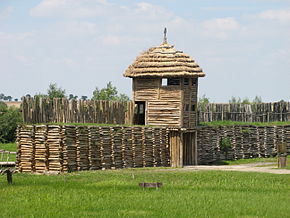Biskupin

Reconstructed Biskupin
|
|
| Location | Kuyavian-Pomeranian Voivodeship, Poland |
|---|---|
| Coordinates | 52°47′19″N 17°43′47″E / 52.78861°N 17.72972°ECoordinates: 52°47′19″N 17°43′47″E / 52.78861°N 17.72972°E |
| Type | Settlement |
| Site notes | |
| Condition | In ruins |
The archaeological open-air museum Biskupin is an archaeological site and a life-size model of an Iron Age fortified settlement in Poland (Kuyavian-Pomeranian Voivodeship). When first discovered it was thought to be early evidence of Slavic settlement but archaeologists later confirmed it belonged to the Biskupin group of the Lusatian culture. The excavation and the reconstruction of the prehistoric settlement has played an instrumental part in Polish historical consciousness.
The Museum is situated on a marshy peninsula in Lake Biskupin, ca. 90 kilometres (56 miles) northeast of Poznań, 8 km (5 mi) south of the small town of Żnin. It is a division of the National Museum of Archaeology in Warsaw.
The site is one of Poland's official national Historic Monuments (Pomnik historii), as designated September 16, 1994, and tracked by the National Heritage Board of Poland.
In 1933 Polish archaeologists discovered remains of a Bronze Age fort/settlement in Wielkopolska (Greater Poland), the discovery became famous overnight. The site was excavated from 1934 onwards by the team from Poznań University, led by archaeologists Józef Kostrzewski (1885–1969) and Zdzisław Rajewski (1907–1974). The first report was published in 1936. By the beginning of 1939, ca. 2,500 m2 (26,909.78 sq ft) had been excavated. Biskupin soon became famous, attracting numerous distinguished guests, including officials of the Marshal Piłsudski government, members of the military, and high churchmen such as the primate of Poland. The site soon became part of Polish national consciousness, the symbol of achievements of the Slavonic forebears in prehistoric times. It was called the "Polish Pompeii" or "Polish Herculaneum". The existence of a prehistoric fortress, 70 km (43 mi) from the German border, was used to show that the prehistoric "Poles" had held their own against foreign invaders and plunderers as early as the Iron Age. Biskupin came to feature in paintings and popular novels.
...
Wikipedia

